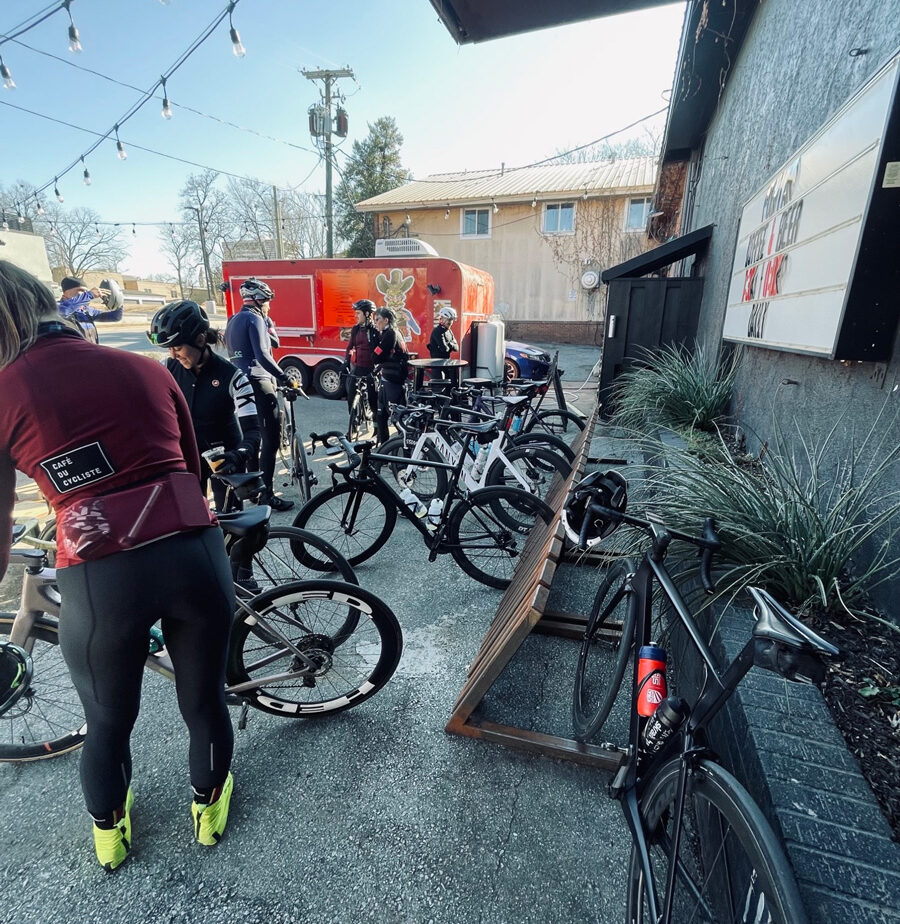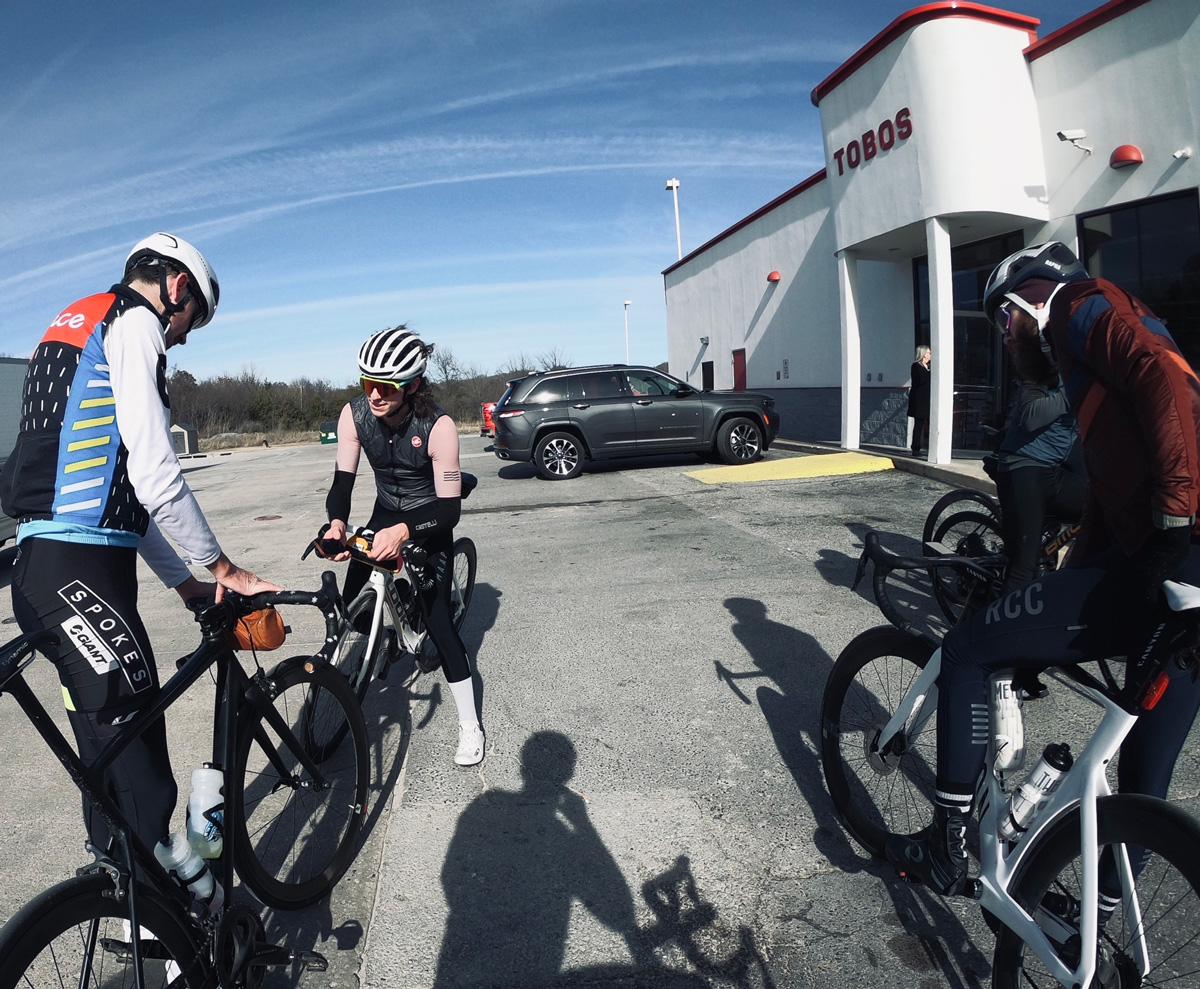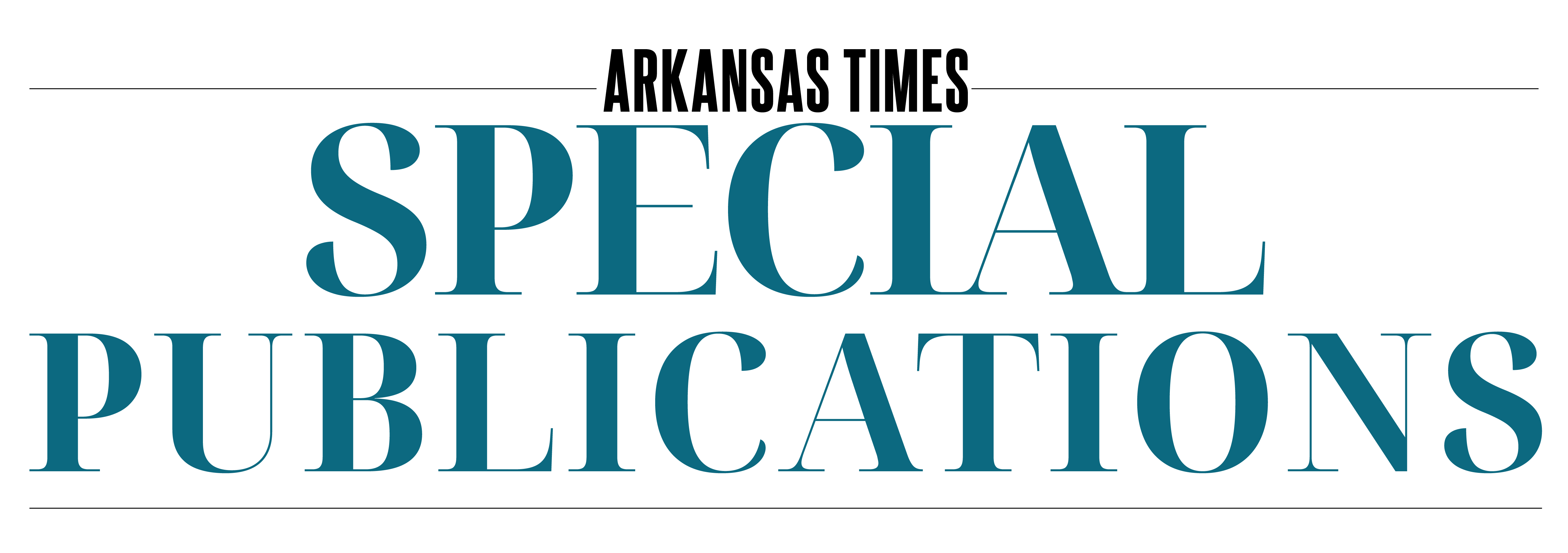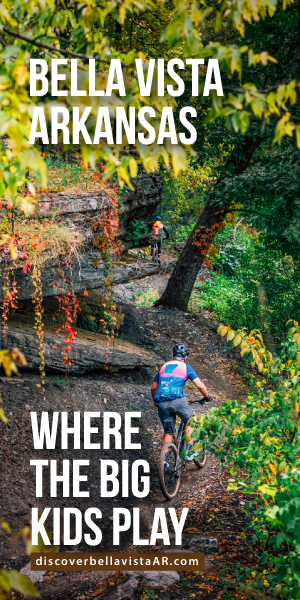A Group Ride
By Bryce Ward | Photography courtesy the group riders

ON THE ROAD: The group ride hits the streets.
Stumble to the caffeine, fumble through the wrinkled laundry: jersey, bibs, socks — where is the other one? Chug the caffeine, climb into your second skin, stuff your pockets with food, fill two bottles with fluid, press your thumb against the tires — good enough — fasten your feet to your shoes, tighten your helmet, follow your bike to the door and exhale the conditioned air.
Push your heavy legs in circles and glide across the oily road. Feel the ground shake beneath you as a person, somewhere inside a massive machine, which protects them from the wind and hills and cold and heat, rushes by your sweat-stained body. Watch them shrink into the distance they have cheated.
Wait — what time is it?
Push your chain down the cassette and lower your head into the invisible resistance.
Jovial voices and the scent of brewed coffee beans greet you when you open the door. Heads turn and watch the oddly dressed person with skin-tight clothing and loud clicking shoes waddle across the lobby of the coffee shop, toward a small congregation of brazen individuals, both young and old, who chat among themselves like land-weary sailors. The cyclists.
“It’s about that time,” one of them declares, and one by one, they gather their strange items, stow away their smartphones, and march out the door, their hardened soles clashing against the concrete floor.
The procession floats along the busy streets. Their bodies play with gravity and lean into sharp-angled turns. Their hands reach out from their sides and point where to go and where not to go, a fluid mass that contorts itself to the surrounding environment.
The sane people watch. Some look with wonder, some with scorn. Some follow with their heads, some with their eyes. But they all look at least once, even just a glance, because how can one not look at such a disruptive activity.

THE COFFEE SHOP: The best rides begin and end amidst the smell of coffee beans and fresh pastries.
Open your eyes.
Find the snooze button.
Fall to your feet.
What day is it?
Sunday. One more day of freedom.
Wait – the group ride.
A group of grown adults, riding bicycles on public roads, roads designed for massive automobiles and high-speed transportation, and there they go, laughing into the face of industrial progress, willfully subjecting themselves to the toils of an antiquated machine, and slowing down the ones who seem to think life goes on forever.
Languid cattle heads rise from the grass and turn in unison to process the unfamiliar intruders; the voices push the cattle up into a state of tense anticipation — not quite standing, not quite prone, their big round eyes and wide open ears searching for the slightest excuse to run.
But the excuse never comes; the intruders move between two long strings of barbed wire and dissolve into the distance as the wind carries away their laughter and lively voices. The cattle stoop back down to the grass and rest their heavy heads.
Like a flock of geese fleeing to warmer air, the cyclists take turns battling the strong headwind. But instead of a V formation, they adopt a sort of W — two at the front, giving shelter to two long lines behind. In regular intervals, set into motion by the outward flick of an elbow, the two riders at the front part in opposite directions and allow the wind to drag them backward, past the conversations and labored breaths, until at last, a space opens for them.
On and on this dance goes, down unfamiliar roads and foreign landscapes. The riders shuffle up and down their formation like pews, exchanging signs of peace with those around them: friends, acquaintances, strangers — anyone who longs to endure.
Hearts pump blood at a rate constantly above rest; legs fall in a perpetual loop; the riders cannot afford to waste their energy on worldly worries; their eyes point to the road ahead and the land around it. They share their voices without reservation, letting thoughts escape with little resistance.
The cyclists descend upon a rural gas station store, release their feet and rest their bikes against the nearest flat surface.
They swarm through the door and permeate the cramped aisles in search of nourishment, hauling their discoveries back to the front counter where a woman — head tilted down, feigning disinterest of the sudden disruption to her quiet office — peers above the frames of her glasses.
“Will that be all for ya?” slips from her mouth like “bless you” after a sneeze.

THE GAS STATION: A mid-ride refuge for the cyclists.
She scans the trove of product, one after another. Coke, Red Bull, liters of water, a honey bun, chips, a corndog. She doesn’t ask questions. She just scans and repeats her song to each odd traveler until the bell above the door finally subsides.
Through tinted windows she watches them: laughing and conversing with each other, excusing themselves to confused locals, recreating experiences through their hands. And she wonders.
A six-pack of Miller Lite clings against the counter.
“Will that be all for ya?”
The tired procession crests a hill that hides their home, a wide cityscape that seems so small and insignificant in the distance. Pedal stroke upon pedal stroke they push their weary bodies back into the painting, to their places among the tall buildings and weaving automobiles. But they move slow, in long labored circles, crawling up steep grades, coasting down hills, immune to the rush of time.
As they sink further into town, the herd thins. One by one, riders veer into the wind and lean into streets that return them to their worlds, to families, careers, school work, car payments and mortgages, dreams and expectations, dirty dishes and wrinkled laundry.


